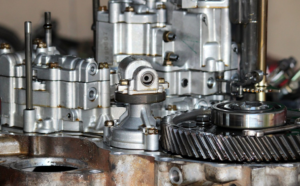
Power steering plays a vital role in your vehicle’s handling and maneuverability. However, when power steering fluid leaks occur, it can lead to various problems, compromising your safety and potentially causing costly damage. In this article, we’ll explore the causes, detection methods, and effective solutions for addressing power steering fluid leaks.
Causes of Power Steering Fluid Leaks:
Leaking Power Steering Pump:
- The power steering pump is responsible for transferring fluid to the steering system. A worn-out pump seal or a broken casing joint gasket can lead to leaks.
Leaking Power Steering Hoses:
- The power steering system comprises pressure and return hoses. Loose seals or cracks in these hoses can cause fluid to leak, leading to steering issues.
Overfilled Power Steering Fluid Reservoir:
- Overfilling the reservoir can result in excess pressure, potentially causing seals in the rack to blow out, leading to leaks.
Power Steering Rack Issues:
- The power steering rack (rack and pinion) can develop leaks due to wear and tear of seals and shafts caused by road grime and dirt.
Using the Wrong Type of Power Steering Fluid:
- Using the incorrect type of fluid can cause damage to the power steering system, leading to wear and tear and potential leaks. Always use the fluid specified for your vehicle.
Detecting Power Steering Fluid Leaks:
Fluid on the Ground:
- Look for pinkish or reddish droplets of fluid under your parked vehicle. This is a clear indicator of a power steering fluid leak.
Ignition Noise:
- If you hear a squealing sound from the steering pump when starting your car, it may indicate a power steering fluid leak.
Grinding or Whining Noise:
- Unusual noises from the steering system, especially when turning, can signal a leak. The noise occurs due to increased friction when fluid lubrication is insufficient.
Stiffness of the Steering Wheel:
- Difficulty in turning the steering wheel or a delayed response can be a sign of fluid leakage, posing a risk, especially during sudden turns.
Repairing Power Steering Fluid Leaks:
Power Steering Pump Replacement:
- If the power steering pump is the source of the leak, it’s crucial to replace it with a new one. Seek professional assistance for this task.
Power Steering Hose Repair or Replacement:
- Tighten loose seals or use Teflon tape to seal threads. If the hose itself is damaged, consider replacing it entirely.
Reservoir Fluid Adjustment:
- If the reservoir is overfilled, use a syringe or turkey baster to remove excess fluid and relieve pressure.
Power Steering Rack Replacement:
- In cases of rack leaks, it’s often necessary to replace the entire power steering rack. Consult with a qualified mechanic for guidance.
Use the Correct Power Steering Fluid: Always ensure you’re using the specified power steering fluid for your vehicle to prevent future leaks.
Power steering fluid leaks are a concern that should never be ignored. They can compromise vehicle safety, lead to costly repairs, and harm the environment. Regular maintenance, prompt detection, and swift action are key to addressing power steering fluid leaks effectively. If you notice any signs of a leak, seek professional assistance to ensure your vehicle remains safe and reliable on the road, starting with an courtesy checkup.




